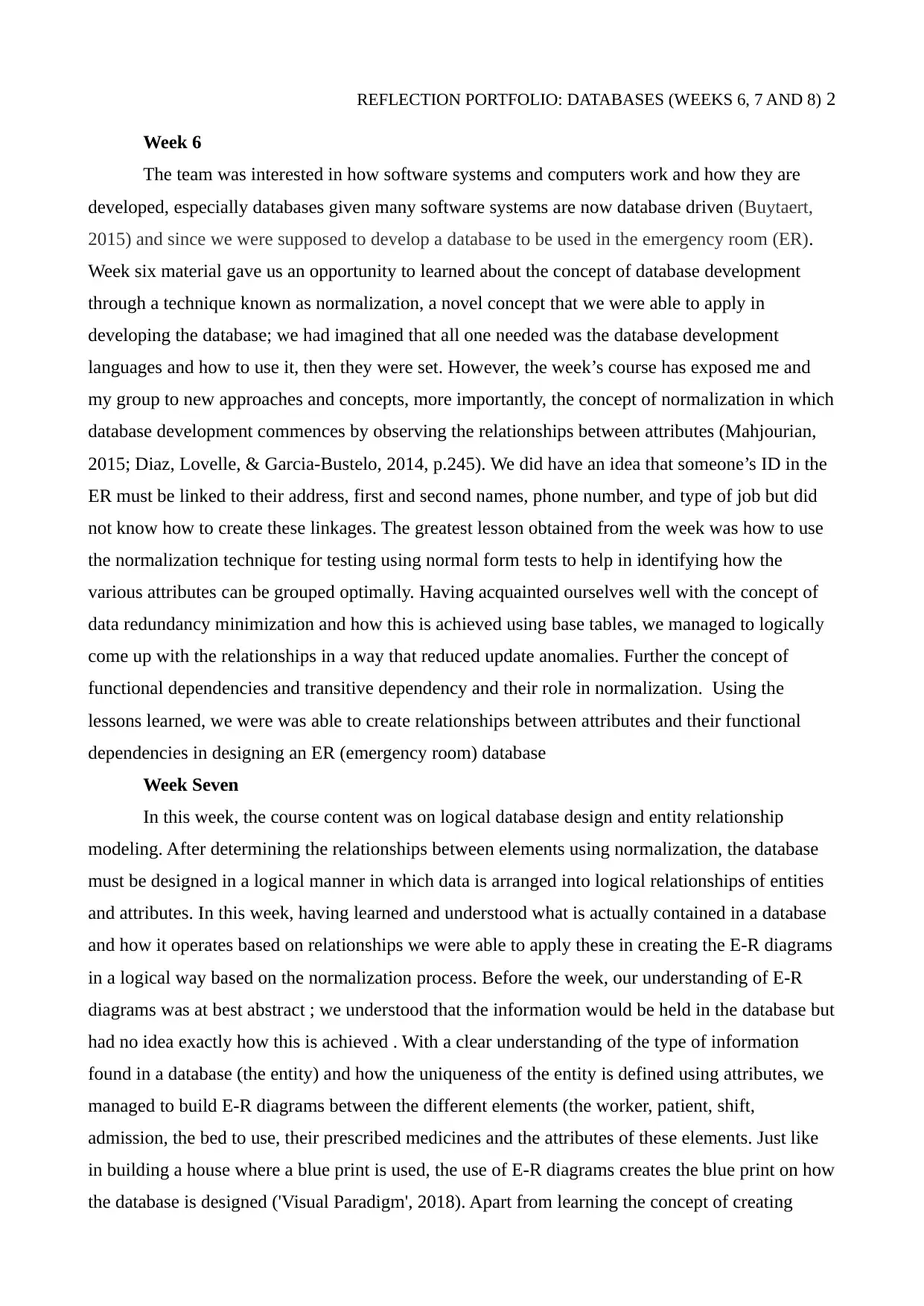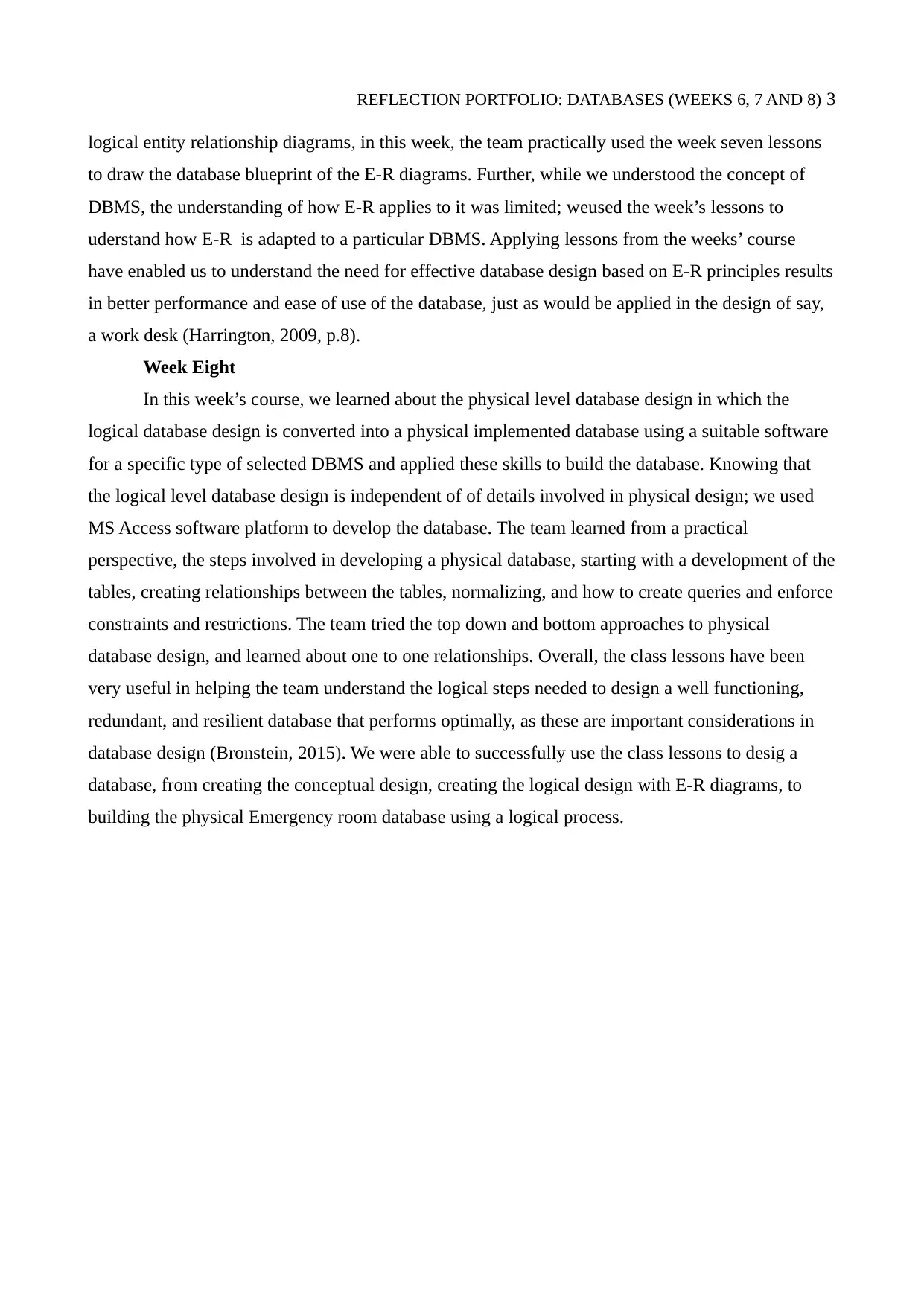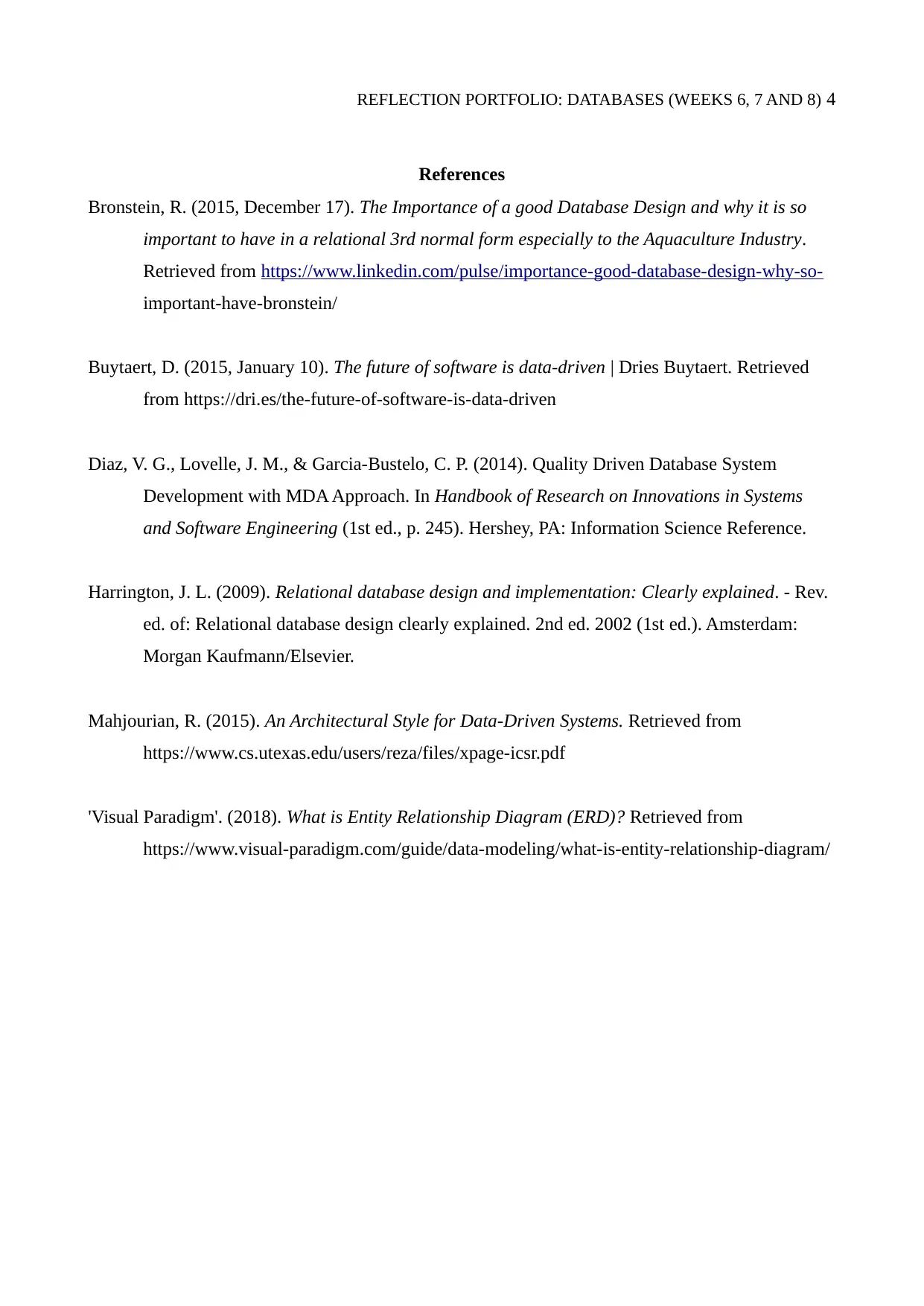Databases Reflection Portfolio: Weeks 6, 7, and 8 - Analysis
VerifiedAdded on 2021/06/16
|4
|1134
|102
Journal and Reflective Writing
AI Summary
This reflection portfolio documents a student's learning journey in database design and development over three weeks, focusing on the application of theoretical concepts to practical database creation. The student explores database development through normalization, learning to minimize data redundancy and identify functional dependencies. The portfolio details the application of entity-relationship (E-R) modeling for logical database design, emphasizing the creation of database blueprints and understanding how E-R diagrams are adapted to a particular DBMS. The final section covers physical database design using MS Access, detailing the steps of table creation, relationship establishment, and query implementation. The student reflects on the importance of well-designed databases for optimal performance and ease of use, highlighting the progression from conceptual design to a functional emergency room database.

REFLECTION PORTFOLIO: DATABASES (WEEKS 6, 7 AND 8) 1
Reflection Portfolio: Databases (Weeks 6, 7 and 8)
Name
Date
Reflection Portfolio: Databases (Weeks 6, 7 and 8)
Name
Date
Paraphrase This Document
Need a fresh take? Get an instant paraphrase of this document with our AI Paraphraser

REFLECTION PORTFOLIO: DATABASES (WEEKS 6, 7 AND 8) 2
Week 6
The team was interested in how software systems and computers work and how they are
developed, especially databases given many software systems are now database driven (Buytaert,
2015) and since we were supposed to develop a database to be used in the emergency room (ER).
Week six material gave us an opportunity to learned about the concept of database development
through a technique known as normalization, a novel concept that we were able to apply in
developing the database; we had imagined that all one needed was the database development
languages and how to use it, then they were set. However, the week’s course has exposed me and
my group to new approaches and concepts, more importantly, the concept of normalization in which
database development commences by observing the relationships between attributes (Mahjourian,
2015; Diaz, Lovelle, & Garcia-Bustelo, 2014, p.245). We did have an idea that someone’s ID in the
ER must be linked to their address, first and second names, phone number, and type of job but did
not know how to create these linkages. The greatest lesson obtained from the week was how to use
the normalization technique for testing using normal form tests to help in identifying how the
various attributes can be grouped optimally. Having acquainted ourselves well with the concept of
data redundancy minimization and how this is achieved using base tables, we managed to logically
come up with the relationships in a way that reduced update anomalies. Further the concept of
functional dependencies and transitive dependency and their role in normalization. Using the
lessons learned, we were was able to create relationships between attributes and their functional
dependencies in designing an ER (emergency room) database
Week Seven
In this week, the course content was on logical database design and entity relationship
modeling. After determining the relationships between elements using normalization, the database
must be designed in a logical manner in which data is arranged into logical relationships of entities
and attributes. In this week, having learned and understood what is actually contained in a database
and how it operates based on relationships we were able to apply these in creating the E-R diagrams
in a logical way based on the normalization process. Before the week, our understanding of E-R
diagrams was at best abstract ; we understood that the information would be held in the database but
had no idea exactly how this is achieved . With a clear understanding of the type of information
found in a database (the entity) and how the uniqueness of the entity is defined using attributes, we
managed to build E-R diagrams between the different elements (the worker, patient, shift,
admission, the bed to use, their prescribed medicines and the attributes of these elements. Just like
in building a house where a blue print is used, the use of E-R diagrams creates the blue print on how
the database is designed ('Visual Paradigm', 2018). Apart from learning the concept of creating
Week 6
The team was interested in how software systems and computers work and how they are
developed, especially databases given many software systems are now database driven (Buytaert,
2015) and since we were supposed to develop a database to be used in the emergency room (ER).
Week six material gave us an opportunity to learned about the concept of database development
through a technique known as normalization, a novel concept that we were able to apply in
developing the database; we had imagined that all one needed was the database development
languages and how to use it, then they were set. However, the week’s course has exposed me and
my group to new approaches and concepts, more importantly, the concept of normalization in which
database development commences by observing the relationships between attributes (Mahjourian,
2015; Diaz, Lovelle, & Garcia-Bustelo, 2014, p.245). We did have an idea that someone’s ID in the
ER must be linked to their address, first and second names, phone number, and type of job but did
not know how to create these linkages. The greatest lesson obtained from the week was how to use
the normalization technique for testing using normal form tests to help in identifying how the
various attributes can be grouped optimally. Having acquainted ourselves well with the concept of
data redundancy minimization and how this is achieved using base tables, we managed to logically
come up with the relationships in a way that reduced update anomalies. Further the concept of
functional dependencies and transitive dependency and their role in normalization. Using the
lessons learned, we were was able to create relationships between attributes and their functional
dependencies in designing an ER (emergency room) database
Week Seven
In this week, the course content was on logical database design and entity relationship
modeling. After determining the relationships between elements using normalization, the database
must be designed in a logical manner in which data is arranged into logical relationships of entities
and attributes. In this week, having learned and understood what is actually contained in a database
and how it operates based on relationships we were able to apply these in creating the E-R diagrams
in a logical way based on the normalization process. Before the week, our understanding of E-R
diagrams was at best abstract ; we understood that the information would be held in the database but
had no idea exactly how this is achieved . With a clear understanding of the type of information
found in a database (the entity) and how the uniqueness of the entity is defined using attributes, we
managed to build E-R diagrams between the different elements (the worker, patient, shift,
admission, the bed to use, their prescribed medicines and the attributes of these elements. Just like
in building a house where a blue print is used, the use of E-R diagrams creates the blue print on how
the database is designed ('Visual Paradigm', 2018). Apart from learning the concept of creating

REFLECTION PORTFOLIO: DATABASES (WEEKS 6, 7 AND 8) 3
logical entity relationship diagrams, in this week, the team practically used the week seven lessons
to draw the database blueprint of the E-R diagrams. Further, while we understood the concept of
DBMS, the understanding of how E-R applies to it was limited; weused the week’s lessons to
uderstand how E-R is adapted to a particular DBMS. Applying lessons from the weeks’ course
have enabled us to understand the need for effective database design based on E-R principles results
in better performance and ease of use of the database, just as would be applied in the design of say,
a work desk (Harrington, 2009, p.8).
Week Eight
In this week’s course, we learned about the physical level database design in which the
logical database design is converted into a physical implemented database using a suitable software
for a specific type of selected DBMS and applied these skills to build the database. Knowing that
the logical level database design is independent of of details involved in physical design; we used
MS Access software platform to develop the database. The team learned from a practical
perspective, the steps involved in developing a physical database, starting with a development of the
tables, creating relationships between the tables, normalizing, and how to create queries and enforce
constraints and restrictions. The team tried the top down and bottom approaches to physical
database design, and learned about one to one relationships. Overall, the class lessons have been
very useful in helping the team understand the logical steps needed to design a well functioning,
redundant, and resilient database that performs optimally, as these are important considerations in
database design (Bronstein, 2015). We were able to successfully use the class lessons to desig a
database, from creating the conceptual design, creating the logical design with E-R diagrams, to
building the physical Emergency room database using a logical process.
logical entity relationship diagrams, in this week, the team practically used the week seven lessons
to draw the database blueprint of the E-R diagrams. Further, while we understood the concept of
DBMS, the understanding of how E-R applies to it was limited; weused the week’s lessons to
uderstand how E-R is adapted to a particular DBMS. Applying lessons from the weeks’ course
have enabled us to understand the need for effective database design based on E-R principles results
in better performance and ease of use of the database, just as would be applied in the design of say,
a work desk (Harrington, 2009, p.8).
Week Eight
In this week’s course, we learned about the physical level database design in which the
logical database design is converted into a physical implemented database using a suitable software
for a specific type of selected DBMS and applied these skills to build the database. Knowing that
the logical level database design is independent of of details involved in physical design; we used
MS Access software platform to develop the database. The team learned from a practical
perspective, the steps involved in developing a physical database, starting with a development of the
tables, creating relationships between the tables, normalizing, and how to create queries and enforce
constraints and restrictions. The team tried the top down and bottom approaches to physical
database design, and learned about one to one relationships. Overall, the class lessons have been
very useful in helping the team understand the logical steps needed to design a well functioning,
redundant, and resilient database that performs optimally, as these are important considerations in
database design (Bronstein, 2015). We were able to successfully use the class lessons to desig a
database, from creating the conceptual design, creating the logical design with E-R diagrams, to
building the physical Emergency room database using a logical process.
⊘ This is a preview!⊘
Do you want full access?
Subscribe today to unlock all pages.

Trusted by 1+ million students worldwide

REFLECTION PORTFOLIO: DATABASES (WEEKS 6, 7 AND 8) 4
References
Bronstein, R. (2015, December 17). The Importance of a good Database Design and why it is so
important to have in a relational 3rd normal form especially to the Aquaculture Industry.
Retrieved from https://www.linkedin.com/pulse/importance-good-database-design-why-so-
important-have-bronstein/
Buytaert, D. (2015, January 10). The future of software is data-driven | Dries Buytaert. Retrieved
from https://dri.es/the-future-of-software-is-data-driven
Diaz, V. G., Lovelle, J. M., & Garcia-Bustelo, C. P. (2014). Quality Driven Database System
Development with MDA Approach. In Handbook of Research on Innovations in Systems
and Software Engineering (1st ed., p. 245). Hershey, PA: Information Science Reference.
Harrington, J. L. (2009). Relational database design and implementation: Clearly explained. - Rev.
ed. of: Relational database design clearly explained. 2nd ed. 2002 (1st ed.). Amsterdam:
Morgan Kaufmann/Elsevier.
Mahjourian, R. (2015). An Architectural Style for Data-Driven Systems. Retrieved from
https://www.cs.utexas.edu/users/reza/files/xpage-icsr.pdf
'Visual Paradigm'. (2018). What is Entity Relationship Diagram (ERD)? Retrieved from
https://www.visual-paradigm.com/guide/data-modeling/what-is-entity-relationship-diagram/
References
Bronstein, R. (2015, December 17). The Importance of a good Database Design and why it is so
important to have in a relational 3rd normal form especially to the Aquaculture Industry.
Retrieved from https://www.linkedin.com/pulse/importance-good-database-design-why-so-
important-have-bronstein/
Buytaert, D. (2015, January 10). The future of software is data-driven | Dries Buytaert. Retrieved
from https://dri.es/the-future-of-software-is-data-driven
Diaz, V. G., Lovelle, J. M., & Garcia-Bustelo, C. P. (2014). Quality Driven Database System
Development with MDA Approach. In Handbook of Research on Innovations in Systems
and Software Engineering (1st ed., p. 245). Hershey, PA: Information Science Reference.
Harrington, J. L. (2009). Relational database design and implementation: Clearly explained. - Rev.
ed. of: Relational database design clearly explained. 2nd ed. 2002 (1st ed.). Amsterdam:
Morgan Kaufmann/Elsevier.
Mahjourian, R. (2015). An Architectural Style for Data-Driven Systems. Retrieved from
https://www.cs.utexas.edu/users/reza/files/xpage-icsr.pdf
'Visual Paradigm'. (2018). What is Entity Relationship Diagram (ERD)? Retrieved from
https://www.visual-paradigm.com/guide/data-modeling/what-is-entity-relationship-diagram/
1 out of 4
Related Documents
Your All-in-One AI-Powered Toolkit for Academic Success.
+13062052269
info@desklib.com
Available 24*7 on WhatsApp / Email
![[object Object]](/_next/static/media/star-bottom.7253800d.svg)
Unlock your academic potential
Copyright © 2020–2025 A2Z Services. All Rights Reserved. Developed and managed by ZUCOL.





